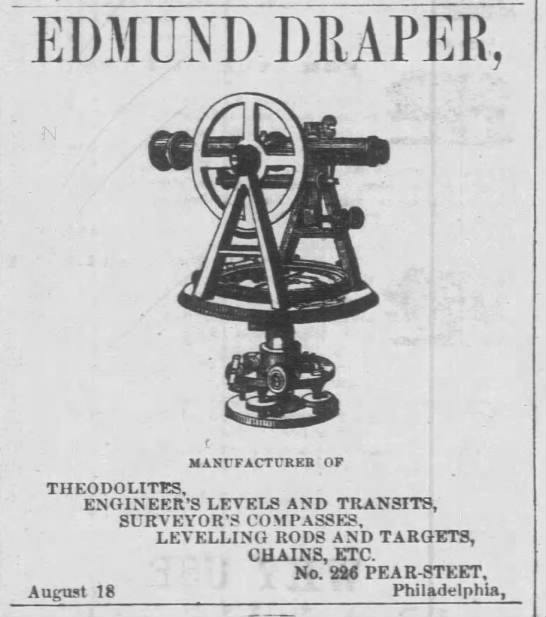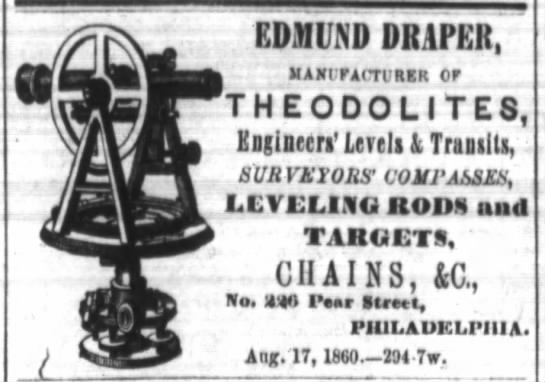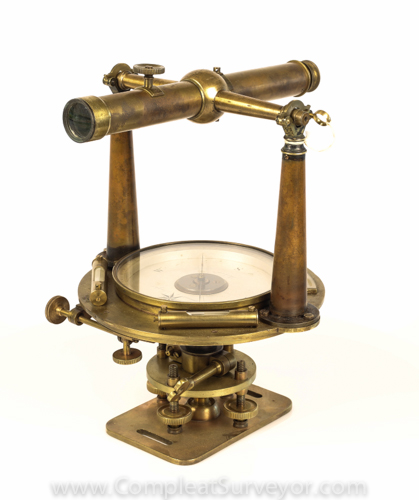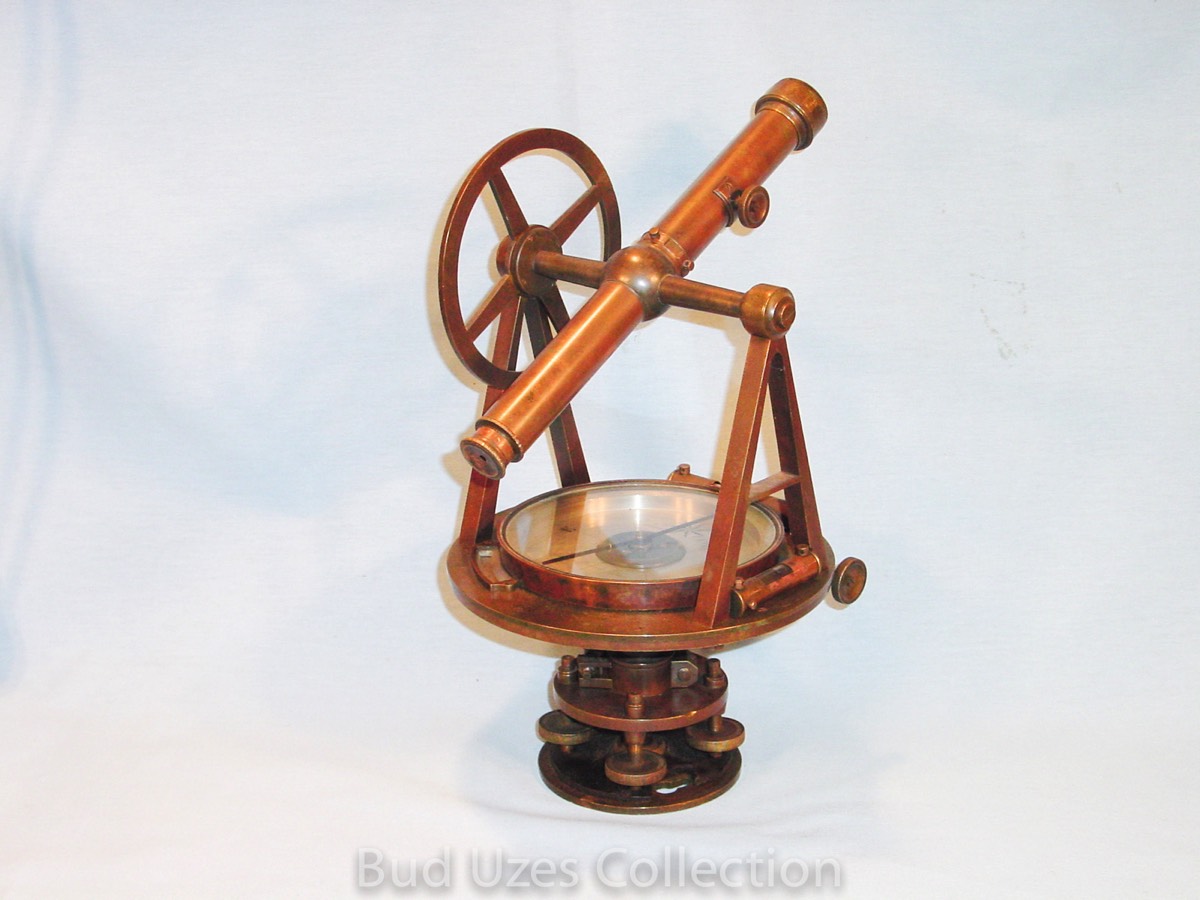
Edmund Draper
History
Edmund Draper
1805-1882
"Edmund Draper was born in Philadelphia in 1805 and died there in 1882. Draper went into business on his own in 1832: the Philadelphia City directories show as follows: 1833-37 Edmund Draper, instrument mf; 1837-38 Draper & Knox, Mathematical Instrument maker, Edmund Draper & Joseph Knox; 1852-82 Edmund Draper, mathematical & optical instrument maker.
In the Fifth edition of the catalog of Young & Sons dated April 1878 is the following paragraph: "About the same time (1830-1835) Mr. Edmund Draper constructed a graduating engine, which, amongst those acquainted with it, has a high reputation for accuracy." He made the first distinctive mine transit about 1850. There are various instruments bearing the name of Stancliffe & Draper. The Philadelphia City Directories do not list Edmund Draper and Benjamin Stancliffe as partners but it is assumed they may have been in partnership between 1830 and 1833."
Draper joined the Franklin Institute in 1825 and became a life member in 1877. He regularly submitted theodolites at their fairs through the 1840s, and was elected to the board of managers in 1849. He was President pro. tem. in 1852, and recording secretary pro. tem. in 1853. The only other mathematical instrument maker to hold office in the Institute was Charles J. Shain.
Draper introduced a shifting head in 1859. This device undoubtedly inspired by the shifting head which Young had patented (#20.915) in 1858 consisted of two rectangular horizontal plates, the lower of which attached to the tripod and the upper to the base of the transit. When the two screws holding the plates together were loosened, the transit could be shifted about an inch in any direction, and when tightened it was held firmly in place. This head was preferable to Young's head when it was necessary to place the transit exactly on a line, as was often required in mine work. Draper's shifting head was provided on his own instruments, as well as those by Young & Sons, Heller & Brightly and others on special order into the 20th century.
Serial numbers are found on about half of the surviving Draper instruments. Those numbers seen to date range from 140 to 626. An unnumbered transit with a Draper shifting head suggests that the numbering started sometime after 1859. I f we assume that Draper began numbering his instruments in 1860 with the number 1 and that all subsequent instruments were numbered, we can conclude that he produced an average of 28 instruments a year up to 1882. This level of production is confirmed by the decennial census of industry , which reported that Draper employed five male hands and produced $8000 worth of goods in 1860, and he employed but two male hands and produced hut $4000 worth of goods in 1870. For comparison, both Young and Sons and Heller and Brightly were producing roughly 100 instruments per year during this period.
While most of Draper's instruments were sold to private individuals, some were sold to government agencies. In 1840, for instance, while surveying the Texas-Mexico border, Maj. J.D. Graham of the Topographical Engineers used a Draper transit-theodolite to obtain the true meridian: and to determine magnetic variation he used a small Draper theodolite with a 4 1/2 “ needle. In 1840, A. D. Bache ordered an instrument "combining compass & graduated circle, with transit telescope and a vertical circle" (which sounds like a complicated description of Young's American transit) for the U.S. Coast Survey. Howard Stansbury used a seven-inch theodolite made by Draper on his exploration of the Great Salt Lake. In 1860, Draper sold a small theodolite and stand for $128 .90 to the Northwest Boundary Commission, to be used along me U.S. Canada boundary from Puget Sound to the summit of the Rockies.
The claim that Draper invented the first American surveyor's transit was advanced by Benjamin Smith Lyman in 1900, and has been repeated in recent years." Lyman's claim was based on the existence of an early transit which "according to tradition was made by Draper in 1821, presumably to he used in surveying the Pennsylvania State canals and the Reading Railroad. The claim apparently was not taken seriously by Lyman since he noted that Draper was only 16 years old in 1821. And it was disproved by Dunbar Scott, who quoted Jay Antrim, Draper's apprentice in 1834, to the effect that "Young's transit was on the market a year before Draper.
Robert Wareham, 1883-1892, Wareham was born in England in 1825. He apprenticed with Draper, and appears as a mathematical instrument maker in the Philadelphia directories from 1851 to 1892. On Draper' s death he opened a shop at 402 Locust and advertised as late foreman for Edmund Draper deceased. A few Wareham instruments are known (including a surveyor's vernier compass with a 5 inch needle) but none have been examined. Wareham died in 1892 leaving an estate valued at only $838.
Edmund Draper died in 1882 leaving the hulk of his estate valued at $ 13068.18 to his brother Robert. There were $1333.46 in stocks and bonds (primarily railroad companies), $5,250 in cash, $387 in furniture at his home, $1,184 in tools and machinery in his shop, Pear and $4000 in real estate.
Labels
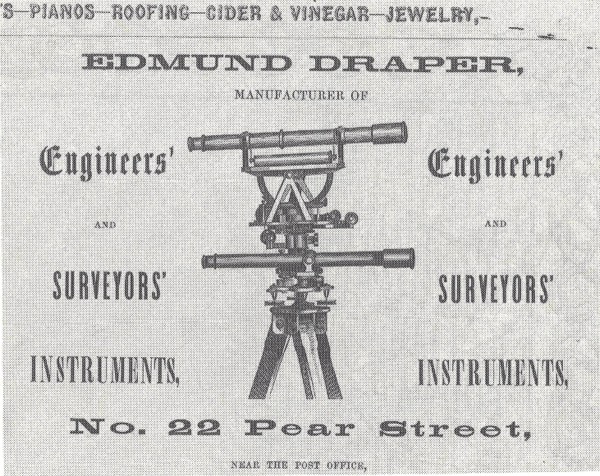
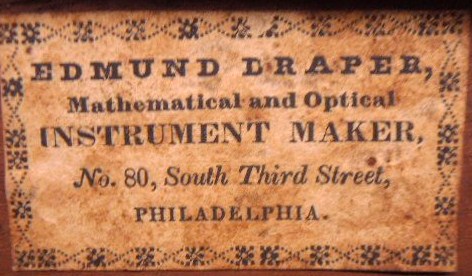

Compleat Surveyor Instruments
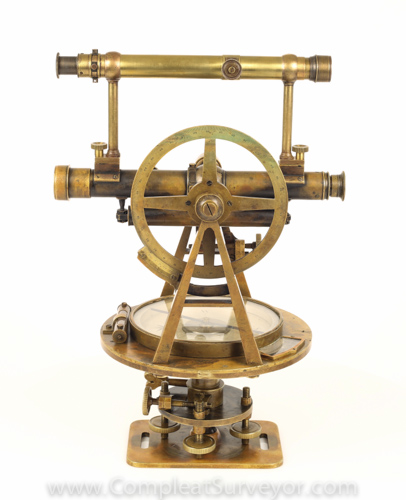
Circa 1860s Draper Mining Transit
360 Degree Spinner View
Very Early Mining Transit - Rare
SOLD - Email Russ
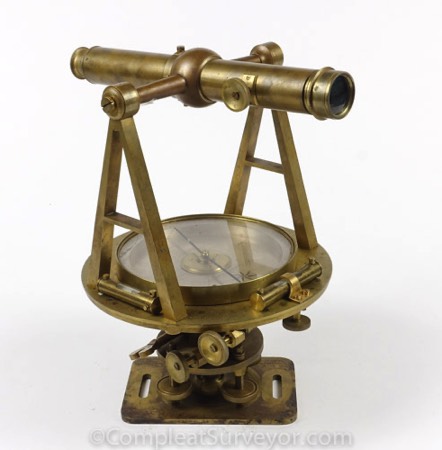
1859 Draper Transit
Rare Pre-Serial Number Plus Shifting Base -
SOLD
Email Russ
Articles
Additional Pictures
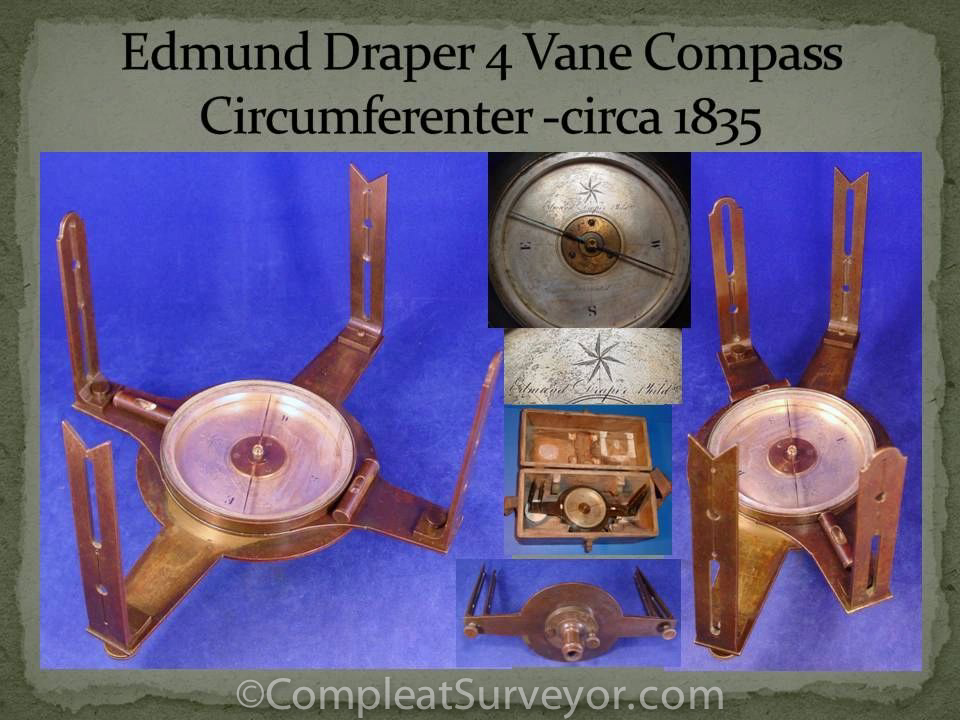

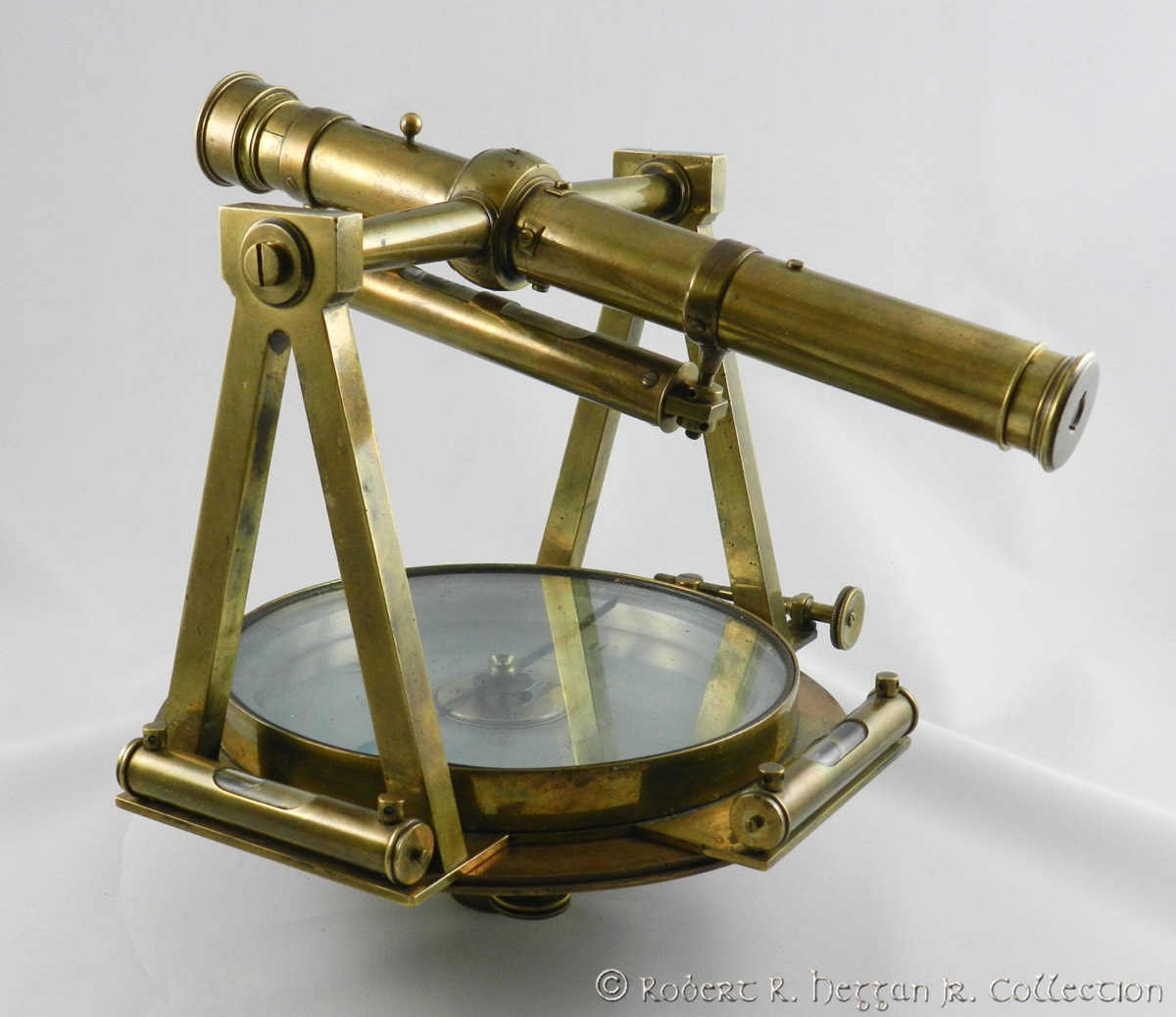
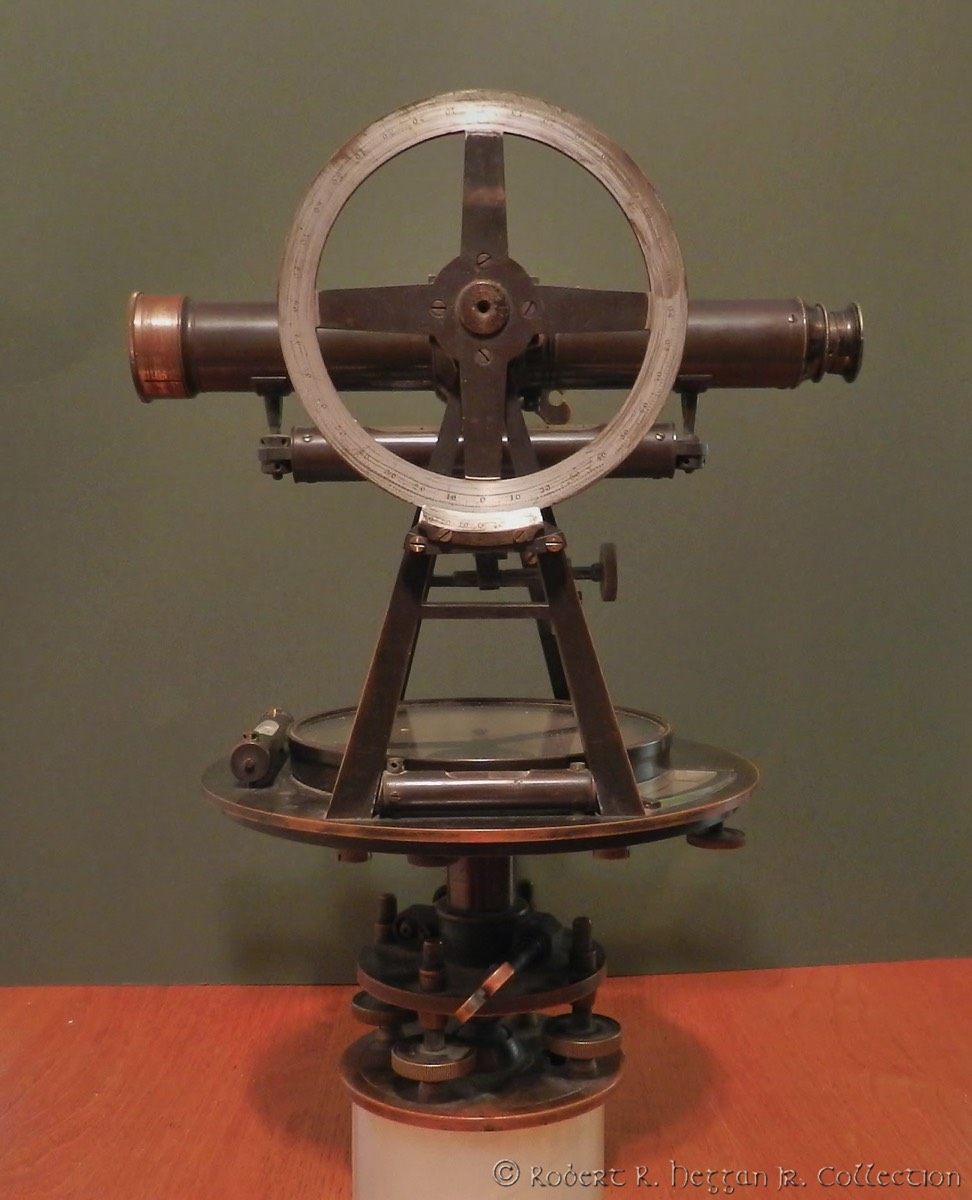
© 2020 Russ Uzes/Contact Me
